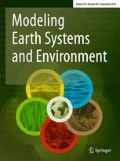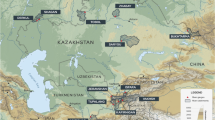Abstract
The objective of this study is to apply HEC–HMS for hydrological modeling of the Gojeb watershed. The daily precipitation and stream flow, Land Use Land Cover (LU/LC), soil, and Digital Elevation Model (DEM) were the data used to achieve the objective. The sensitivity analysis of the watershed parameters showed that Curve Number (CN), initial abstraction ratio (λ), and lag time (tlag) were most sensitive, whereas wave travel time (K) and channel storage coefficient (x) were moderately sensitive. The sensitivity of these parameters signifies that LU/LC, soil types, topography, and channel geometry, which are the dominant runoff causative factors, are lumped by these parameters. Model calibration and validation were conducted from 2002 to 2008 and 2009 to 2014, respectively. The selected objective functions during the calibration and validation periods were PEP (Percentage Error in simulated Peak), PEV (Percentage Error in simulated Volume), Nash–Sutcliffe efficiency (NSE), Root Mean Square Error (RMSE), Percent bias (PBIAS), and Coefficient of Determination (R2). Their respective values during the calibration period were 16.44%, 10.3%, 0.81, 10.42m3/s, 11.64% and 0.87; and during the validation period, 3.92%, 22.95%, 0.551, 12.85 m3/s, 22.91% and 0.73. The result showed that HEC–HMS well simulated the daily runoff of the Gojeb watershed. The average monthly observed and simulated flow during the entire simulation period were 1,044.9m3/s and 841.4m3/s, respectively, whereas the annual average observed and simulated runoff values of the watershed were 12,538.8 m3/s and 10,096.8m3/s, respectively. Hydrological modeling of the Gojeb watershed helps to better understand the effect of watershed management practices on surface runoff. The HEC–HMS model can also be used for water scarce areas with limited data or for ungauged watersheds.















Similar content being viewed by others
References
Abushandi E, Merkel B (2013) Modelling rainfall-runoff relations using HEC-HMS and IHACRES for a single rain event in an Arid Region of Jordan. Water Resour Manag 27(7):2391–2409. https://doi.org/10.1007/s11269-013-0293-4
Ali M et al (2011) Simulation of the impacts of land-use change on surface runoff of Lai Nullah Basin in Islamabad. Pakistan Landsc Urban Plan 102(4):271–279. https://doi.org/10.1016/j.landurbplan.2011.05.006
Aliye MA et al (2020) Evaluating the performance of HEC-HMS and SWAT hydrological models in simulating the rainfall-runoff process for data scarce Region of Ethiopian Rift Valley Lake Basin. Open Journal of Modern Hydrology 10(04):105–122. https://doi.org/10.4236/ojmh.2020.104007
Belayneh A et al (2020) Evaluation of satellite precipitation products using HEC-HMS model. Model Earth Syst Environ 6(4):2015–2032. https://doi.org/10.1007/s40808-020-00792-z
Ben Khélifa W, Mosbahi M (2021) Modeling of the rainfall-runoff process using HEC-HMS model for an urban ungauged watershed in Tunisia. Model Earth Syst Environ. https://doi.org/10.1007/s40808-021-01177-6
Chea S, Oeurng C (2017) Flow simulation in an ungauged catchment of Tonle Sap Lake Basin in Cambodia: application of the HEC-HMS model. Water Utility J 17:3–17
Cheah R et al (2019) Geospatial modelling of watershed peak flood discharge in Selangor. Malaysia Water (Switz) 11(12):1–12. https://doi.org/10.3390/w11122490
Choto M, Fetene A (2019) Impacts of land use/land cover change on stream flow and sediment yield of Gojeb watershed, Omo-Gibe basin, Ethiopia. Remote Sens Appl Soc Environ 14:84–99. https://doi.org/10.1016/j.rsase.2019.01.003
Chu X, Steinman A (2009) Event and continuous hydrologic modeling with HEC-HMS. J Irrig Drain Eng 135(1):119–124. https://doi.org/10.1061/(asce)0733-9437(2009)135:1(119)
Dagnachew M et al (2020) Land use land cover changes and its drivers in gojeb river catchment, omo gibe basin. Ethiop J Agric Environ Int 114(1):33–56. https://doi.org/10.12895/jaeid.20201.842
De Silva MMGT, Weerakoon SB, Herath S (2014) Modeling of event and continuous flow hydrographs with HEC–HMS: case study in the Kelani River Basin, Sri Lanka. J Hydrol Eng 19(4):800–806. https://doi.org/10.1061/(asce)he.1943-5584.0000846
Derdour A, Bouanani A, Babahamed K (2018) Modelling rainfall runoff relations using HEC-HMS in a semi-arid region: case study in Ain Sefra watershed, Ksour Mountains (SW Algeria). J Water Land Dev 36(1):45–55. https://doi.org/10.2478/jwld-2018-0005
Descheemaeker K, Poesen J, Borselli L, Nyssen J, Raes D, Haile M, Muys B, Deckers J (2008) Runoff curve numbers for steep hillslopes with natural vegetation in semi-arid tropical highlands, northern Ethiopia. Hydrol Processes 22(20):4097–4105. https://doi.org/10.1002/hyp.7011
Gebre SL (2015) Application of the HEC-HMS model for runoff simulation of upper Blue Nile River Basin. J Waste Water Treat Anal. https://doi.org/10.4172/2157-7587.1000199
Halwatura D, Najim MMM (2013) Application of the HEC-HMS model for runoff simulation in a tropical catchment. Environ Model Softw 46(Augest 2016):155–162. https://doi.org/10.1016/j.envsoft.2013.03.006
Hamdan ANA, Almuktar S, Scholz M (2021) Rainfall-runoff modeling using the hec-hms model for the al-adhaim river catchment, northern iraq. Hydrology. https://doi.org/10.3390/hydrology8020058
Hu S, Shrestha P (2020) Examine the impact of land use and land cover changes on peak discharges of a watershed in the midwestern United States using the HEC-HMS model. Pap Appl Geogr 6(2):101–118. https://doi.org/10.1080/23754931.2020.1732447
Hwang SH, Kim KB, Han D (2020) Comparison of methods to estimate areal means of short duration rainfalls in small catchments, using rain gauge and radar data. J Hydrol 588:125084. https://doi.org/10.1016/j.jhydrol.2020.125084
Ibrahim-Bathis K, Ahmed SA (2016) Rainfall-runoff modelling of Doddahalla watershed—an application of HEC-HMS and SCN-CN in ungauged agricultural watershed. Arab J Geosci 9(3):1–16. https://doi.org/10.1007/s12517-015-2228-2
JHS B, et al (2019) The influence of spatial discretization on HEC-HMS modelling: a case study. Int J Hydrol 3(5):442–449. https://doi.org/10.15406/ijh.2019.03.00209
Joo J et al (2014) A comparison of two event-based flood models (ReFH-rainfall runoff model and HEC-HMS) at two Korean catchments, Bukil and Jeungpyeong. KSCE J Civ Eng 18(1):330–343. https://doi.org/10.1007/s12205-013-0348-3
Kabiri R, Ramani Bai V, Chan A (2015) Assessment of hydrologic impacts of climate change on the runoff trend in Klang Watershed. Malaysia Environ Earth Sci 73(1):27–37. https://doi.org/10.1007/s12665-014-3392-5
Kaffas K, Hrissanthou V (2014) Application of a continuous rainfall-runoff model to the basin of kosynthos river using the hydrologic software HEC-HMS. Glob Nest J 16(1):188–203. https://doi.org/10.30955/gnj.001200
Koneti S, Sunkara SL, Roy PS (2018) Hydrological modeling with respect to impact of land-use and land-cover change on the runoff dynamics in Godavari river basin using the HEC-HMS model. ISPRS Int J Geo-Inform. https://doi.org/10.3390/ijgi7060206
Kumarasamy K, Belmont P (2018) Calibration parameter selection and watershed hydrology model evaluation in time and frequency domains. Water (Switz). https://doi.org/10.3390/w10060710
Majidi A, Shahedi K (2012) Simulation of rainfall-runoff process using green-ampt method and HEC-HMS model (Case Study: Abnama Watershed, Iran). Int J Hydraul 1(1):5–9. https://doi.org/10.5923/j.ijhe.20120101.02
Moriasi DN, Arnold JG, Van Liew MW, Bingner RL, Harmel RD, Veith TL (2007) Model evaluation guidelines for systematic quantification of accuracy in watershed simulations. Trans ASABE 50(3):885–900
Najim MMM, Babel MS, Loof R (2006) AGNPS model assessment for a mixed forested watershed in Thailand. Science Asia 32:53e61. https://doi.org/10.1002/hyp.1344
Natarajan S, Radhakrishnan N (2019) Simulation of extreme event-based rainfall–runoff process of an urban catchment area using HEC-HMS. Model Earth Syst Environ 5(4):1867–1881. https://doi.org/10.1007/s40808-019-00644-5
Orellana B, Pechlivanidis IG, McIntyre N, Wheater HS and Wagener T (2008) A toolbox for the identification of parsimonious semi-distributed rainfall-run of models: application to the Upper Lee catchment. In: iEMSs 2008: International Congress on Environmental Modelling and Software. Barcelona, Spain
Paudel M et al (2011) Comparing the capability of distributed and lumped hydrologic models for analyzing the effects of land use change. J Hydroinform 13(3):461–473. https://doi.org/10.2166/hydro.2010.100
Pechlivanidis IG, Jackson BM, Mcintyre NR, Wheater HS (2011) Catchment scale hydrological modelling: a review of model types, calibration approaches, and uncertainty analysis methods in the context of recent developments in technology and applications. Glob Nest J 13(3): 193–214. https://doi.org/10.30955/gnj.000778
Raes D, Willems P, Gbaguidi F (2006) RAINBOW–a software package for hydrometeorological frequency analysis and testing the homogeneity of historical data sets. In: Proceedings of the 4th International Workshop on ‘Sustainable management of marginal drylands (SUMAMAD): 27–31. Avaialbe at https://www.witpress.com/Secure/elibrary/papers/HY96/HY96052FU.pdf. Accessed 19 May 2021
Rahman KU et al (2017) Sub-catchments flow losses computation using Muskingum-Cunge routing method and HEC-HMS GIS based techniques case study of Wadi Al-Lith. Saudi Arabia Model Earth Syst Environ. https://doi.org/10.1007/s40808-017-0268-1
Ramly S, Tahir W (2016) Application of HEC-GeoHMS and HECHMS as rainfall–runof model for food simulation. In ISFRAM 2015. Springer, pp 181–192. doi: https://doi.org/10.1007/978-981-10-0500-8
Revell N et al (2021) Modelling the hydrological effects of woodland planting on infiltration and peak discharge using hec-hms. Water (Switz). https://doi.org/10.3390/w13213039
Roy D, Begam S, Ghosh S, Jana S (2013) Calibration and validation of HEC-HMS model for a river basin in Eastern India. ARPN J Eng Appl Sci 8(1):40–56
Sahour H, Mokhtari A, Ghahfarokhi S S (2016) Rainfall-runoff modeling using remotely sensed data and the Hydrologic Modeling System (HEC-HMS) Ecol Environ Conserv22 (4): 1735–1745
Sardoii ER et al (2012) Calibration of loss estimation methods in HEC-HMS for simulation of surface runoff (case study: Amirkabir dam watershed, Iran). Adv Environ Biol 6(1):343–348
Senay GB, Verdin JP (2004) Developing index maps of water−harvest potential in AFRICA. Am Soc Agric Eng 20(6):789–800
Seyoum M et al (2013) Precipitation forecasts for rainfall runoff predictions. A case study in poorly gauged ribb and gumara catchments, Upper Blue Nile, Ethiopia. Phys Chem Earth 61–62:43–51. https://doi.org/10.1016/j.pce.2013.05.005
Shah M, Lone MA (2021) Hydrological modeling to simulate stream flow in the Sindh Valley watershed, northwest Himalayas. Model Earth Syst Environ. https://doi.org/10.1007/s40808-021-01241-1
Shiferaw H et al (2021) Evaluating ecosystems services values due to land use transformation in the Gojeb watershed, Southwest Ethiopia. Environ Syst Res. https://doi.org/10.1186/s40068-021-00227-3
Skhakhfa ID, Ouerdachi L (2016) Hydrological modelling of Wadi ressoul watershed, Algeria, by HEC-HMS model. J Water Land Dev 31(1):139–147. https://doi.org/10.1515/jwld-2016-0045
Song XM, Kong FZ, Zhu ZX (2011) Application of Muskingum routing method with variable parameters in ungauged basin. Water Sci Eng 4(1):1–12. https://doi.org/10.3882/j.issn.1674-2370.2011.01.001
Tassew BG, Belete MA, Miegel K (2019) Application of HEC-HMS model for fow simulation in the Lake Tana Basin: the case of gilgel abay catchment Upper Blue Nile Basin Ethiopia. Hydrology 6(1):21. https://doi.org/10.3390/hydrology6010021
U.S. Army Corps of Engineers (2017) Hydrologic Modeling System ; Application Guide. (June), p. 158. Available at https://www.hec.usace.army.mil/software/hec-hms/documentation/HEC-HMS_Applications_Guide_June2017.pdf. Accessed 05 Mar 2020
Verma AK, Jha MK, Mahana RK (2010) Evaluation of HEC-HMS and WEPP for simulating watershed runoff using remote sensing and geographical information system. Paddy Water Environ 8(2):131–144. https://doi.org/10.1007/s10333-009-0192-8
Wałȩga A (2013) Application of HEC-HMS programme for the reconstruction of a flood event in an uncontrolled basin. J Water Land Dev 18(9):13–20. https://doi.org/10.2478/jwld-2013-0002
Wang M, Zhang L, Baddoo TD (2016) Hydrological Modeling in A Semi-Arid Region Using HEC-HMS. J Water Resour Hydraul Eng 5(3):105–115. https://doi.org/10.5963/jwrhe0503004
Zelelew DG, Langon S (2020) Selection of appropriate loss methods in HEC-HMS model and determination of the derived values of the sensitive parameters for un-gauged catchments in Northern Ethiopia. In J River Basin Manag 18(1):127–135. https://doi.org/10.1080/15715124.2019.1672701
Zelelew DG, Melesse AM (2018) Applicability of a spatially semi-distributed hydrological model for watershed scale runoff estimation in Northwest Ethiopia. Water (Switz) 10(7):10–12. https://doi.org/10.3390/w10070923
Zou KH, Tuncali K, Silverman SG (2003) Correlation and simple linear regression. Radiology 227(3):617–628. https://doi.org/10.1148/radiol.2273011499
Acknowledgements
The authors would like to acknowledge MoWIE, EMA and MAE for providing the necessary spatial and non-spatial data for this study.
Author information
Authors and Affiliations
Corresponding author
Ethics declarations
Conflict of interest
The authors declare no conflict of interest.
Additional information
Publisher's Note
Springer Nature remains neutral with regard to jurisdictional claims in published maps and institutional affiliations.
Rights and permissions
About this article
Cite this article
Fanta, S.S., Tadesse, S.T. Application of HEC–HMS for runoff simulation of Gojeb Watershed, Southwest Ethiopia. Model. Earth Syst. Environ. 8, 4687–4705 (2022). https://doi.org/10.1007/s40808-022-01397-4
Received:
Accepted:
Published:
Issue Date:
DOI: https://doi.org/10.1007/s40808-022-01397-4




